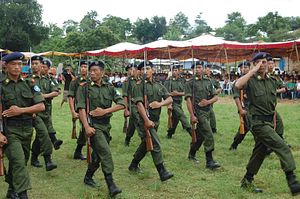The Indian government has decided to firm up another peace agreement in the disturbed border state of Nagaland, which is home to one of the longest running insurgencies in the post-colonial world.
The development comes 22 years after the Isak-Muivah faction of the National Socialist Council of Nagalim (NSCN-IM) – considered the “mother” of all insurgent outfits in India’s northeast – signed a ceasefire agreement with the government to explore the possibility of a negotiated settlement.
Talks were initiated in 2003 after the NSCN(IM) submitted an exhaustive list of demands, but little progress has since been achieved. Several interlocutors have been changed and the talks were also on the verge of breakdown more than once over certain issues that the government was unwilling to accept.
For instance, the NSCN(IM)’s demand of Greater Nagalim, which envisages bringing all Naga in India’s northeast under a single administrative mechanism, would have necessitated changing the boundaries of three other states in the region. The other states have already passed resolutions in their respective assemblies opposing the proposal and the central government has also ruled out accepting the demand. Certain other demands like separate currency and representation at the United Nations for this entity have also been rejected years ago.
In 2005, a framework agreement was also concluded between the government and the NSCN(IM), which provided for a settlement within the Indian union, including a ‘special status’ for Nagaland and recognition of the ‘unique’ history of the Nagas.
In the past few years, six more militant outfits in Nagaland called the Naga National Political Groups (NNPG) have been engaged by the government in talks for the agreement. The government’s objective is to avoid the repetition of past incidents in the hilly northeastern state when an accord clinched with one rebel group had been rejected by the other groups with the result that the issues could never be resolved. The most glaring example comes from the Shillong Accord of 1975, when an agreement was inked by the government with a few senior functionaries of the Naga National Council (NNC) only to be rejected by hardliners who later joined hands to form the NSCN in Myanmar.
The Nagas’ desire to remain a separate political entity had been expressed as early as 1929 when a a memorandum submitted to the Simon Commission by the Naga Club asserted that the Nagas would not join India after independence. In 1947, the Nine Point Agreement was concluded between the NNC and the interim government of India just two months ahead of the country’s independence, which said that the status of Nagaland would be reviewed after ten years. The agreement was interpreted differently by the NNC and the Indian government, which further reduced the scope of resolving the burning issues.
The insurgency in Nagaland and the Naga inhabited region of Manipur in India’s northeast commenced from the mid-1950s after the Naga National Council (NNC) came into being, which also formed the Federal Government of Nagaland (FGN) and a military wing. In 1963, Nagaland was carved out as a separate state from Assam by the government and followed by a ceasefire between the government and the NNC in the following year. This lasted only for three years. The subsequent milestones were the Shillong Accord, the birth of the NSCN IN 1980 and its split into the Isak-Muivah (NSCN-IM) and Khaplang (NSCN-K) factions eight years later.
The ongoing negotiations have also been mired in controversies. The government’s decision to reject the NSCN(IM)’s demand of a separate flag and constitution for the state has not gone down well with a large section of Nagas in India’s northeast. However, six rebel groups are willing to accept the government’s offer but their opinion that further negotiation on the twin demands could continue in the post-agreement phase is unacceptable to many other organizations.
The last meeting held in New Delhi between Naga delegates and government representatives on October 24 ended without any result. After the meeting, government officials told the media that the negotiations would continue to break the deadlock. Earlier, governor of Nagaland and interlocutor R N Ravi had stated that an agreement would be clinched by October 31.
Fearing disturbances, the government has also alerted the army and police in Nagaland. There were reports that the NSCN(IM) had shifted its armory from the designated camps in the state in anticipation of a raid by the government forces.
Rajeev Bhattacharyya is a senior journalist in Assam, India.

































